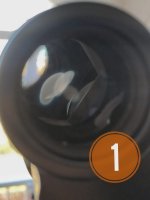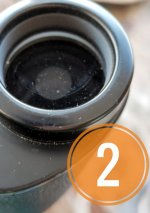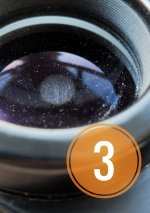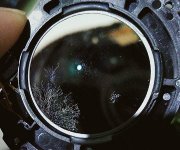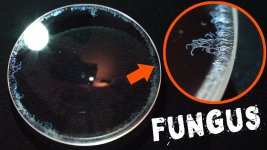I live in a pretty humid environment, so it’s not unusual to have non-sealed binoculars fogged internally, in this case a 8x30 Nikon EII. It’s not the first time I get it. But this morning I've got something I've never seen before.
Picture 1. This is what I usually get, a crescent of fog (actually, it's usually 2 crescents, or the reflection of one). I’ve got a very limited knowledge of optics construction, but judging from what I can see from the outside, I’d say they appear to be located more or less where the prisms are supposed to be.
But now the new (and puzzling thing).
Picture 2. Today, I’ve got a new thing: a perfectly round patch of fog on the inner side of the objective lens, right in the center.
Picture 3. And now comes the puzzling bit. As soon as the binoculars have gained temperature and the fogging was starting to dissipate, the circle of fog on the inner side of the objective lens has started shrinking, concentrating and gaining contrast. It has gone from a misty “dull grey” shade to a more contrasty and whitish fog that has revealed a pretty clear (and worrying, if I may say so) pattern, something like "spaghetti scratches", for lack of a better term. Have a close look at the central part of Picture 3.
Since the binoculars have never been disassembled, I assume the pattern that the fog has exposed has something to do with the last stages of polishing/cleaning of the lenses in the factory, it looks like the result of using some kind of brush, but this is pure speculation. So I assume it is a usual thing that normally does not get exposed. Actually, had I not stayed to see what became of the round patch of fog, I would have never been aware of it.
Maybe someone with a good knowledge of the workings of lenses and binocular building can shed a light and explain what's going on? (Bill, Henry, Gijs, etc.).
Truth be told, once the fog has finally disappeared, the EII have gone back to normal, and the view is lovely as always. While looking at an old vine on the verge of a field, a blackcap has just appeared on the FOV.
Picture 1. This is what I usually get, a crescent of fog (actually, it's usually 2 crescents, or the reflection of one). I’ve got a very limited knowledge of optics construction, but judging from what I can see from the outside, I’d say they appear to be located more or less where the prisms are supposed to be.
But now the new (and puzzling thing).
Picture 2. Today, I’ve got a new thing: a perfectly round patch of fog on the inner side of the objective lens, right in the center.
Picture 3. And now comes the puzzling bit. As soon as the binoculars have gained temperature and the fogging was starting to dissipate, the circle of fog on the inner side of the objective lens has started shrinking, concentrating and gaining contrast. It has gone from a misty “dull grey” shade to a more contrasty and whitish fog that has revealed a pretty clear (and worrying, if I may say so) pattern, something like "spaghetti scratches", for lack of a better term. Have a close look at the central part of Picture 3.
Since the binoculars have never been disassembled, I assume the pattern that the fog has exposed has something to do with the last stages of polishing/cleaning of the lenses in the factory, it looks like the result of using some kind of brush, but this is pure speculation. So I assume it is a usual thing that normally does not get exposed. Actually, had I not stayed to see what became of the round patch of fog, I would have never been aware of it.
Maybe someone with a good knowledge of the workings of lenses and binocular building can shed a light and explain what's going on? (Bill, Henry, Gijs, etc.).
Truth be told, once the fog has finally disappeared, the EII have gone back to normal, and the view is lovely as always. While looking at an old vine on the verge of a field, a blackcap has just appeared on the FOV.
Attachments
Last edited:




